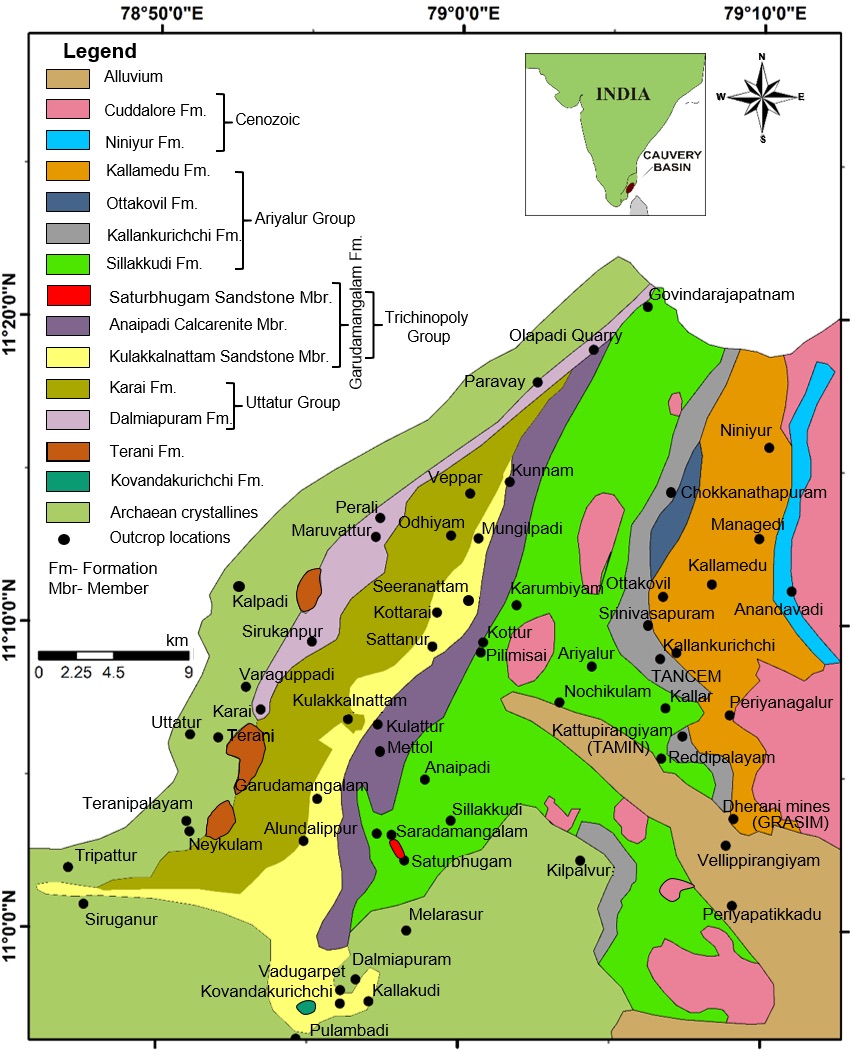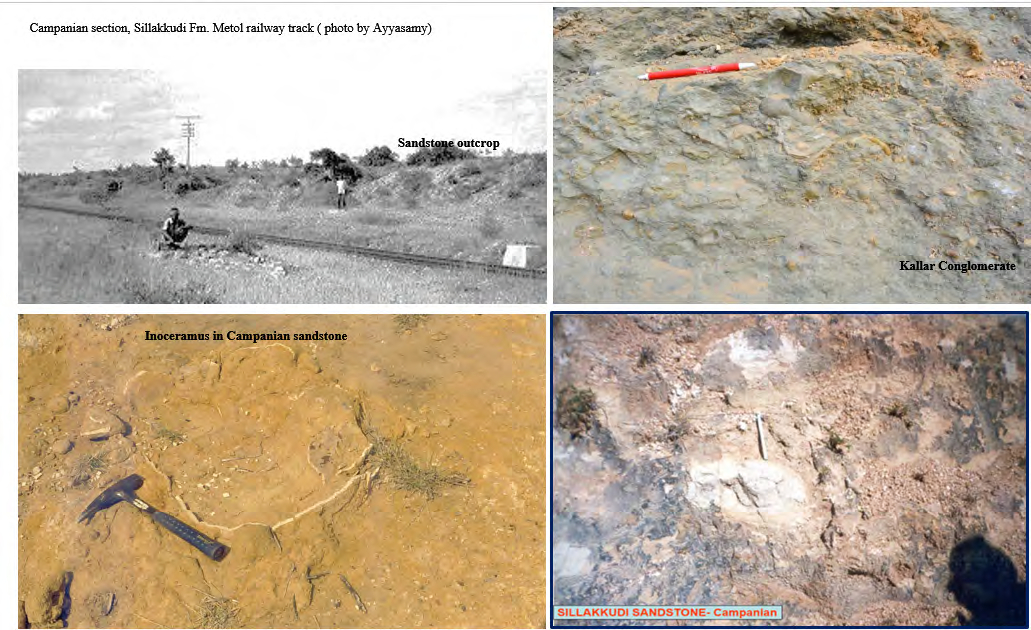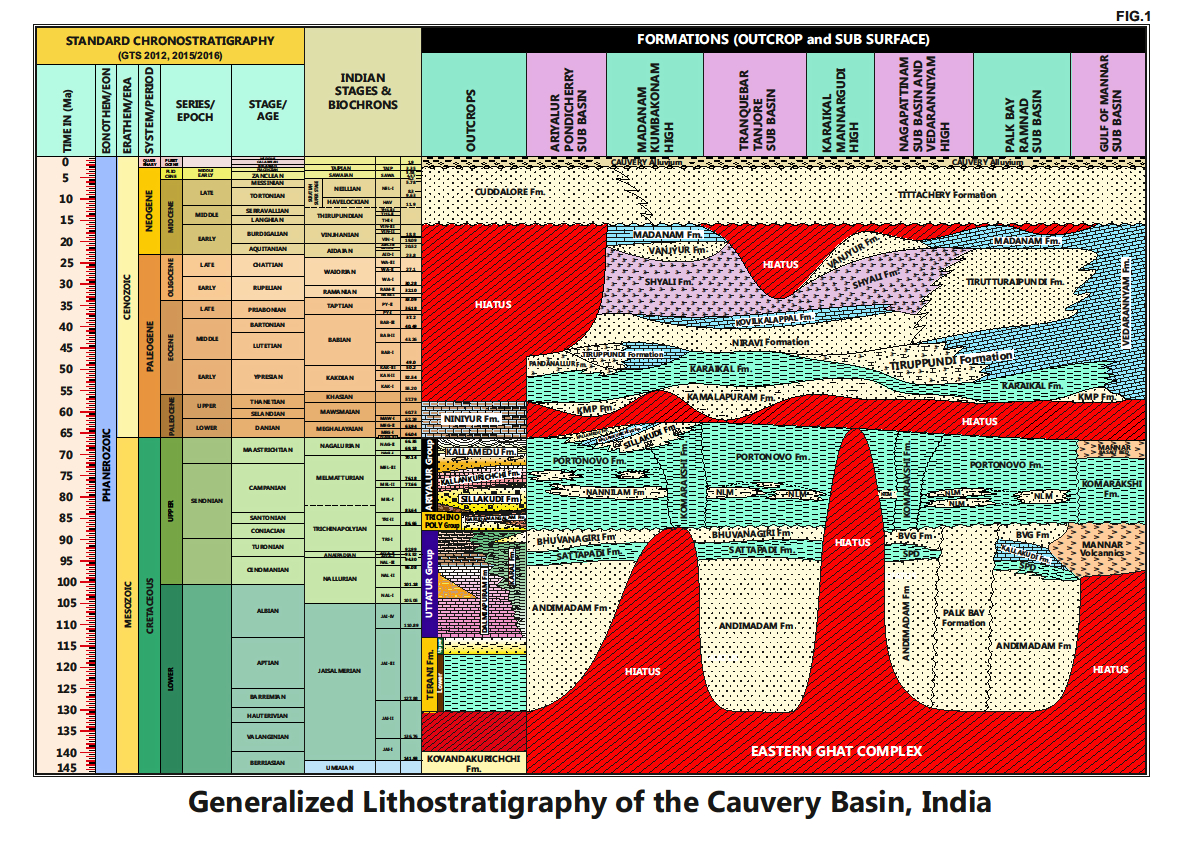Sillakkudi Fm
Type Locality and Naming
ARIYALUR-TRICHIRAPPALLI OUTCROP: Named after Sillakkudi village stream section, Mettol village, Ariyalur district, TamilNadu. Type locality = Mettol Railway cutting east of Sillakkudi and Karapadi villages. Reference section is in drainage ditches bordering the road between Ariyalur and the village of Mel-Mattur
[Figure 1: Geologic map of Ariyalur area]
Lithology and Thickness
Sandstone. Well-sorted, fine- to medium-grained quartz sandstone, clayey, poorly indurated but with well-cemented concretionary beds and sporadic sub spherical concretions. Planar and cross laminated sets are common, as are massive beds. Layer-parallel and gently inclined burrows are present.
This formation thins from south to north and has a maximum thickness of approximately 600 m (Sundaram et al., 2001)
[Figure 2: Field photos of Sillakkudi Formation. Campanian section of Sillakkudi Fm along Metol railway track; Kallar Conglomerate; Inoceramus in sandstone; Sillakkudi Sandstone (provided by A. Nallapa Reddy and R. Nagendra)]
[Figure 3: Generalized Stratigraphy of Cauvery Basin (Provided by A. Nallapa Reddy & R. Nagendra)]
Relationships and Distribution
Lower contact
Unconformity, spanning late Santonian, is present between the Sillakkudi Formation and the underlying fluvial-facies Saturbhugam Sandstone Member of the Garudamangalam Fm and Sillakkudi Fm. During this period the basin appears to be under erosive and/ or fluvial regime. The occurrence of fresh feldspar and sandstone clasts suggests incision into older facies and defined as sequence boundary at the base of this unit (Tewari et al., 1996 and Nagendra et al., 2011).
Upper contact
Unconformable contact with Kallankurichchi Fm. Upper surface of the Kallar Conglomerate Member is unconformably overlain by the Ferruginous limestone of Kallankurichchi Fm
Regional extent
Sillakkudi Formation has the largest areal extent in comparison to other formations in the outcrop (Tewari et al., 1996).
GeoJSON
Fossils
Inoceramus, Lamellibranchs and echinoid fragments. Foraminifera- Rasheed and Ravindran (1978) have reported a rich foraminifera assemblage viz. Globotruncana arca (Cushman), Gt.ventricosa and Gt. elevata which suggests Campanian age for this formation. Ammonites: Karapadites karapadense zone by Sastry et al. (1968) assigns Campanian age.
Age
Depositional setting
Shallow marine. The textural maturity and cross lamination suggests deposition as a mobile substrate subjected to the episodic development of dune bed forms. These attributes and the presence of diverse Mollusca indicate deposition under shallow-marine condition. The calcareous Kilpalvur Member was developed under conditions of local transgression and represents a littoral to a shallow subtidal assemblage (Sundaram et al., 2001)
Additional Information
Sillakkudi Sandstone is fine- to medium-grained sand, sub-rounded-rounded, and angular and moderate to poorly sorted and is classified as quartz sandstone (Q 97.45% F2.41% L0.14%). Monocrystalline quartz>Polycrystalline quartz, plagioclase feldspar is dominant. Biotite, opaque mineral and zircon form the accessory mineralogy of Sillakkudi Sandstone. The modal composition of the Sillakkudi Sandstone reveals a continental block provenance where orogenic forces were absent and rapid erosion under hot and humid conditions which lead to dissolution of feldspar and lithic fragments. The relative percentage of free-floating grains (33%) and point contact (46%) cemented by calcite suggests that the sandstone were subjected to early cementation process, consequently petite compaction effects. The long contact (17%) suggests that the mechanical compaction was more dominant than the chemical compaction, indicated by relative low percentage of sutured and concavo-convex contacts. Calcite cement (90%) and ferruginous cement (10%) were identified in the Sillakkudi Sandstone. Calcite was the first cement precipitated in the pore spaces of sandstone, which is deciphered by the 33% free-floating and 46% point contact grains were cemented by calcite cement and was replaced by the ferruginous cement which was precipitated in the later stages of diagenesis. Loss in porosity was due to early cementation process in comparison to the compaction process, hence, the compaction is the secondary process in porosity reduction (Sargam Chatterjee and Nagendra, 2018).


